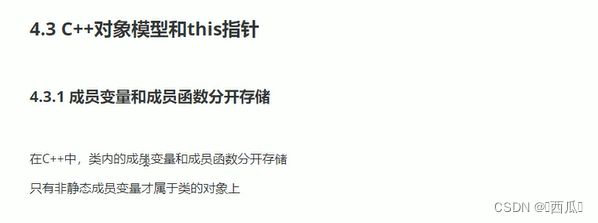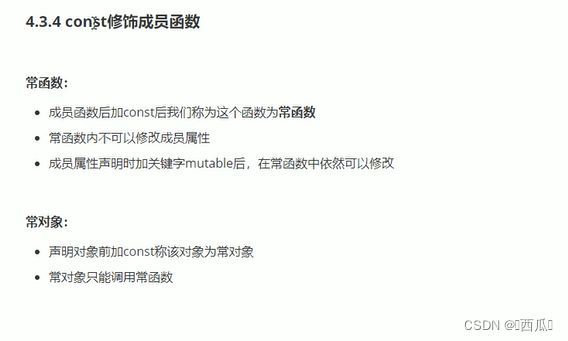C++类和对象-C++对象模型和this指针->成员变量和成员函数分开存储、this指针概念、空指针访问成员函数、const修饰成员函数
#include
using namespace std;
//成员变量 和 成员函数 分开储存的
class Person {
public:
Person() {
mA = 0;
}
//非静态成员变量占对象空间
int mA;
//静态成员变量不占对象空间
static int mB;
//函数也不占对象空间,所有函数共享一个函数实例
void func() {
cout << "mA:" << this->mA << endl;
}
//静态成员函数也不占对象空间
static void sfunc() {
}
};
int Person::mB = 0;
void test01()
{
Person p;
//空对象占用内存空间:1
//C++编译器会给每个空对象也分配一个字节空间,是为了区分空对象占内存的位置
//每个空对象也应该有一个独一无二的内存地址
cout <<"size of p =" <
void test02()
{
Person p;
cout <<"size of p =" <
int main() {
//test01();
test02();
system("pause");
return 0;
}
#include
using namespace std;
class Person
{
public:
Person(int age)
{
//1、当形参和成员变量同名时,可用this指针来区分
//this指针指向 被调用的成员函数 所属的对象
this->age = age;
}
Person& PersonAddPerson(Person p)
{
this->age += p.age;
//返回对象本身
//this指向p2的指针,而*this指向的就是p2这个对象的本体
return *this;
}
int age;
};
void test01()
{
//1.解决名称冲突
Person p1(10);
cout << "p1.age = " << p1.age << endl;
//2.返回对象本身用*this
Person p2(10);
//链式编程思想
p2.PersonAddPerson(p1).PersonAddPerson(p1).PersonAddPerson(p1);
cout << "p2.age = " << p2.age << endl;
}
int main() {
test01();
system("pause");
return 0;
}
#include
using namespace std;
//空指针调用成员函数
class Person
{
public:
void ShowClassName()
{
cout << "我是Person类!" << endl;
}
void ShowPersonAge()
{
if (this == NULL)
{
return;
}
//报错原因是传入的指针为NULL
cout << this->mAge << endl;
}
public:
int mAge;
};
void test01()
{
Person * p = NULL;
p->ShowClassName(); //空指针,可以调用成员函数
p->ShowPersonAge(); //但是如果成员函数中用到了this指针,就不可以了
}
int main() {
test01();
system("pause");
return 0;
}
#include
using namespace std;
//常函数
class Person
{
public:
Person()
{
m_A = 0;
m_B = 0;
}
//this指针的本质是一个指针常量,指针的指向不可修改
//const Person * const this
//在成员函数后面加const,修饰的是this指向,让指针指向的值也不可以修改
void ShowPerson() const
{
//this = NULL; //this指针不可以修改指针的指向 Person* const this;
//this->mA = 100; //但是this指针指向的对象的数据是可以修改的
//const修饰成员函数,表示指针指向的内存空间的数据不能修改,除了mutable修饰的变量
this->m_B = 100;
}
void MyFunc()
{
mA = 10000;
}
public:
int m_A;
mutable int m_B; //特殊变量,即使在常函数中,也可以修改这个值
};
//const修饰对象 常对象
void test01() {
const Person person; //在对象前加const,变为常对象
cout << person.m_A << endl;
//person.mA = 100; //常对象不能修改成员变量的值,但是可以访问
person.m_B = 100; //但是常对象可以修改mutable修饰成员变量
//常对象只能调用常函数
person.ShowPerson();
//person.MyFunc(); //常对象 不能调用普通成员函数,因为普通成员函数可以修改属性
}
int main() {
test01();
system("pause");
return 0;
}



